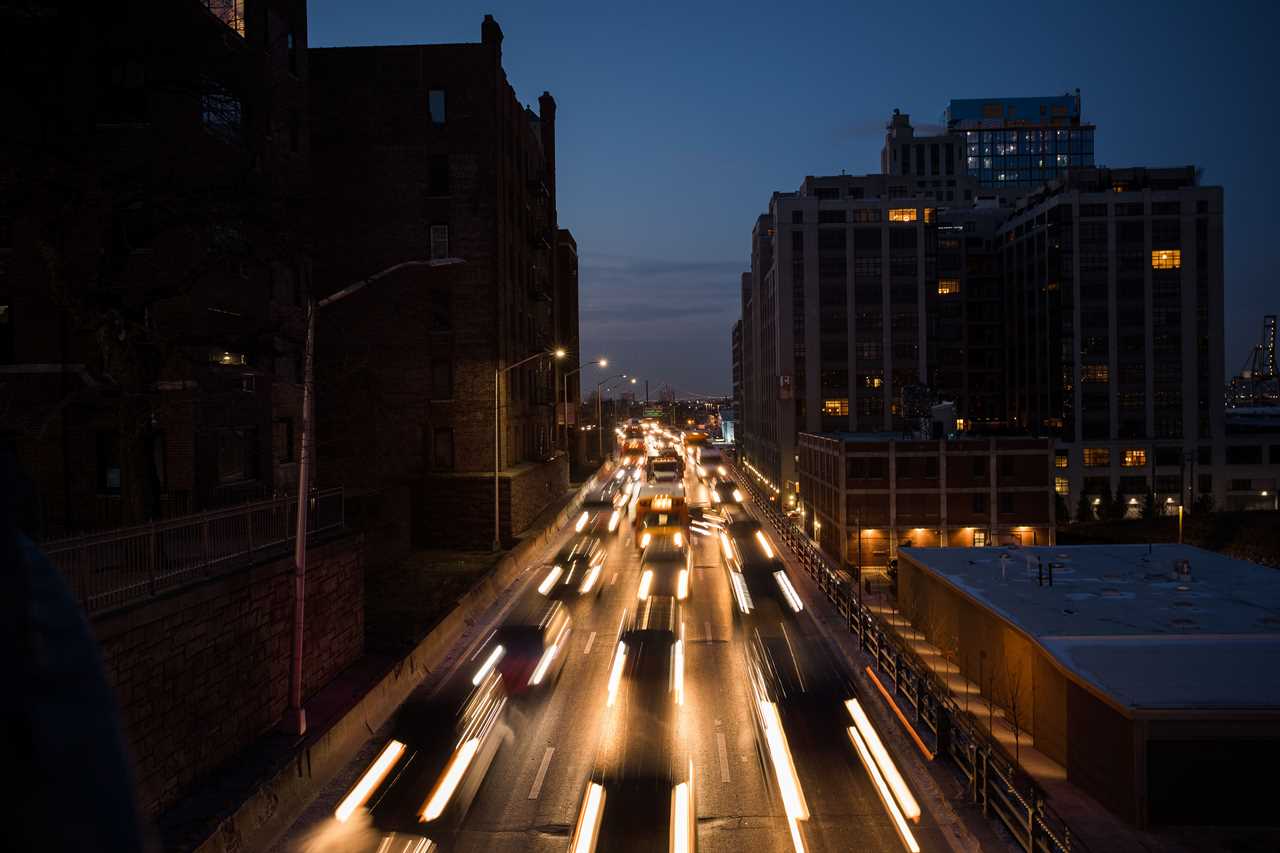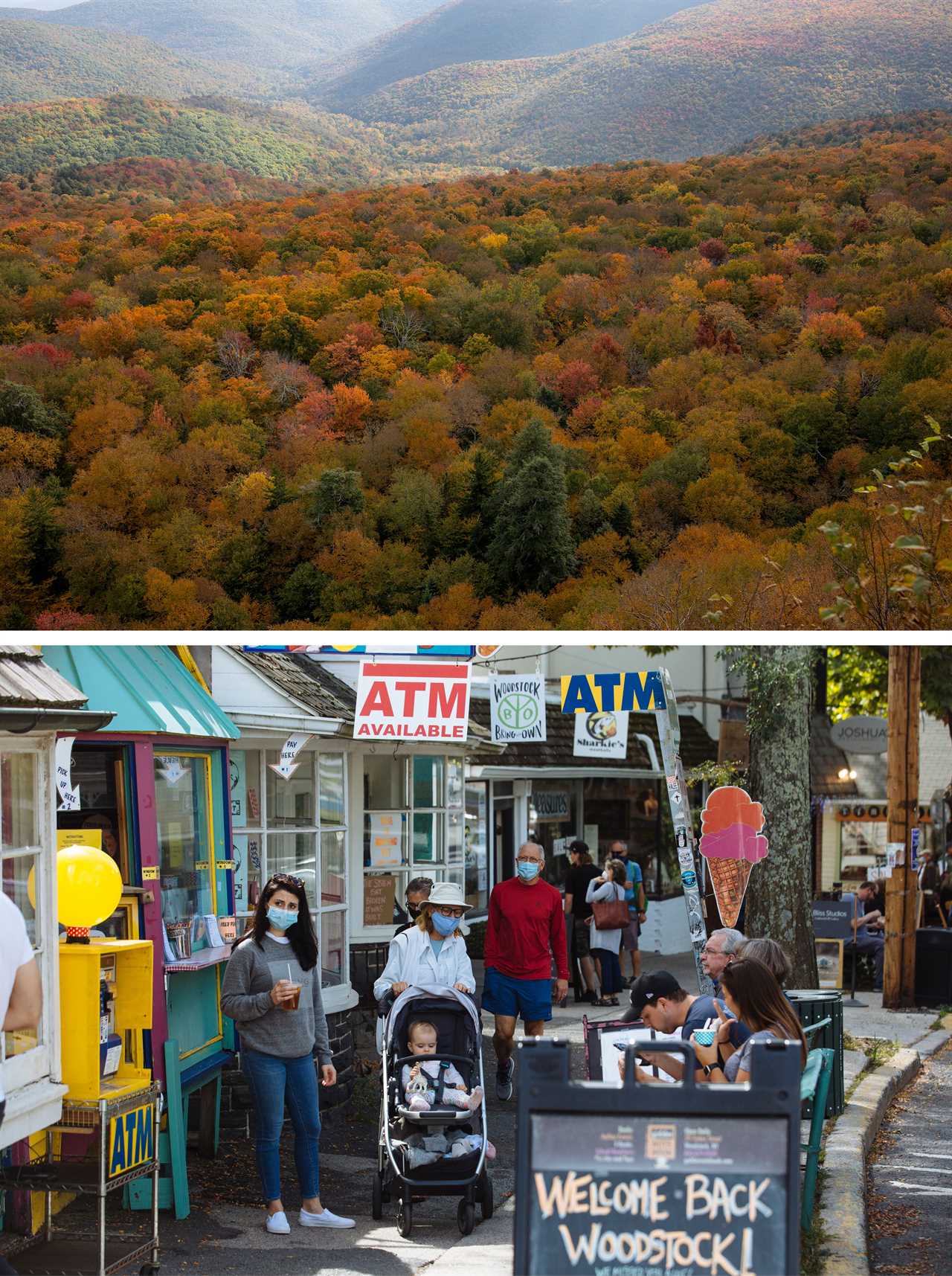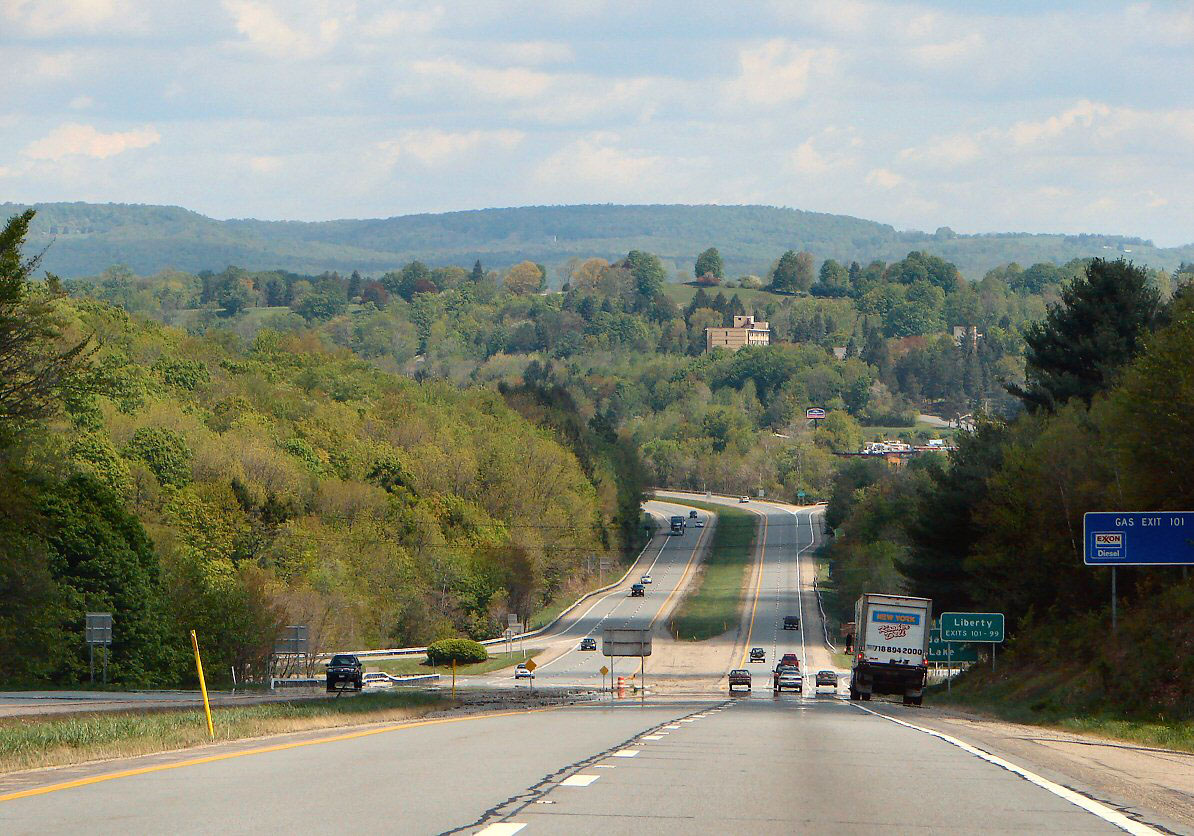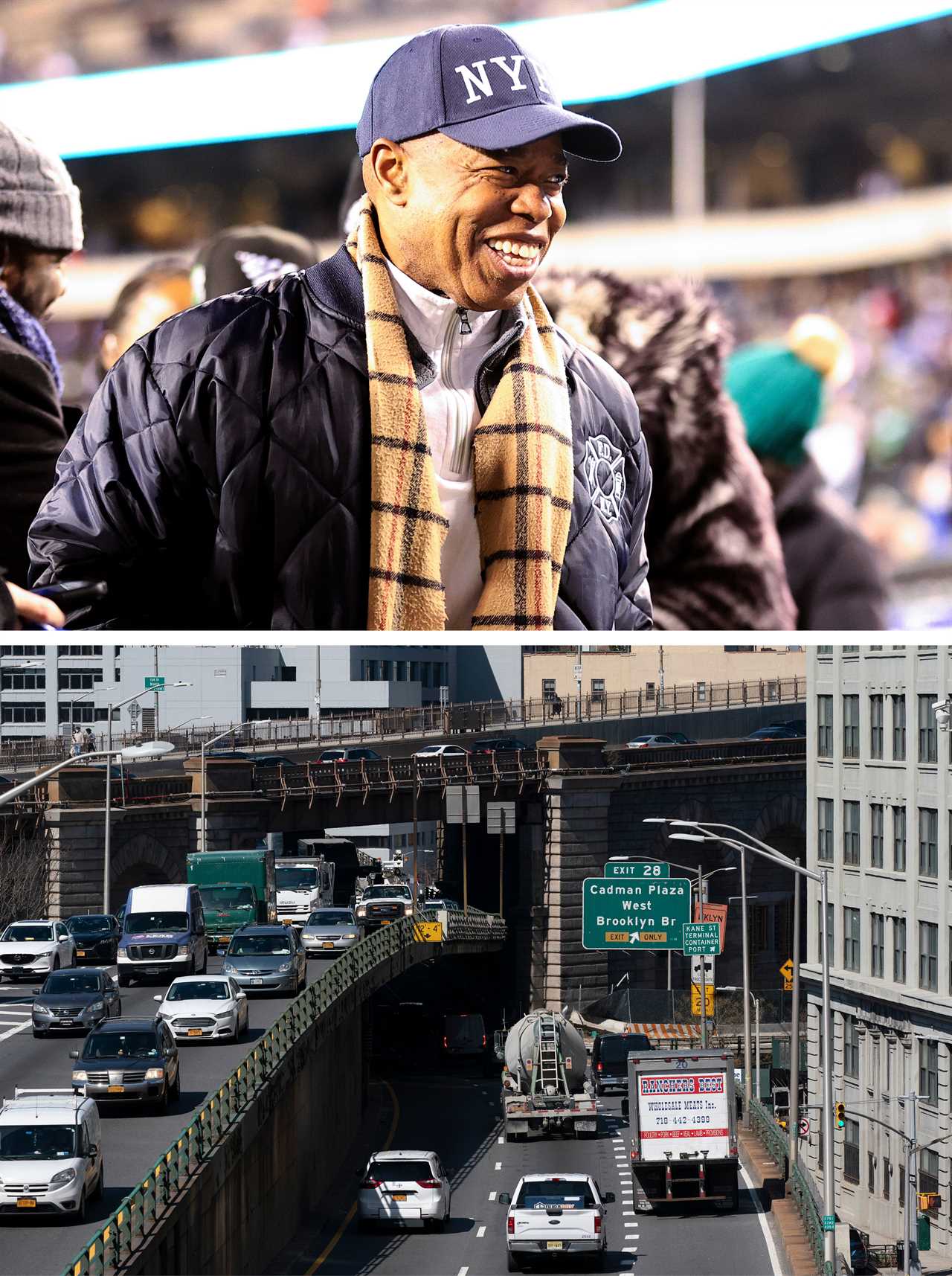
NEW YORK — Thousands of New Yorkers escape the sweltering heat of the concrete jungle each summer by fleeing their Brooklyn brownstones and Upper West Side co-ops and driving west on Route 17, the winding highway leading to the cooler air of the Catskill Mountains.
The revival of the old Borscht Belt in recent years has come with increased traffic down the two-lane state highway — an issue that’s irked Senate Majority Leader Chuck Schumer, who began a push over a decade ago to expand a nearly 50-mile stretch of Route 17.
Now, the project has new momentum under Gov. Kathy Hochul, one of many such proposals to benefit from the $1 trillion federal infrastructure package Congress approved in 2021. But supporters aren't celebrating yet. First, the project must overcome opposition from local and national environmental groups who say the addition of a third lane in both directions will increase the number of gas-guzzling vehicles zipping through the forested region.
“We're spending a billion dollars on 47 miles of highway expansion that don't need it, pumping an additional 2 million tons of greenhouse gasses” into the air through 2050, said Ramsay Adams, the executive director of the Catskill Mountainkeeper, a local environmental advocacy group fighting the widening project. “If it moves forward the way it seems to, it's going to be a problem. It's going to be an issue that I think a lot of us are gonna take up in the courts.”

After years of federal disinvestment, state transportation departments are actively working through a backlog of capital projects, many of which have been stuck for years awaiting viable funding sources. The bipartisan infrastructure law will deliver roughly $350 billion to state transportation departments for highway work over the next five years, the largest investment in roads and bridges in decades. New York expects to get $13.5 billion for highways and bridges, a 40 percent increase over the last five-year federal program.
The Biden administration initially attempted to place guardrails on how the new highway money is spent, releasing guidance encouraging states to prioritize road maintenance and upgrades over paving new lanes, but abandoned the effort amid fierce pushback from Republicans.
Absent federal intervention, many states continue to pursue highway widenings, though not without opposition. In Maryland, environmental groups have sued to stop the expansion of Interstate 270. Opposition is also building in New Jersey over a proposal to spend nearly $5 billion to expand eight miles of highway leading to the Holland Tunnel.

Efforts to stop such projects have had mixed results. Texas can move forward with the controversial expansion of Interstate 45, after federal officials closed a two-year civil rights probe of the project. Yet other transit departments have opted to shelve capacity upgrades following concerted pushback, including in Los Angeles.
Perhaps nowhere is this pressure to balance environmental goals and transportation needs felt more acutely than New York, where Democrats passed one of the most aggressive climate laws in the country in 2019 to cut greenhouse gas emissions 85 percent from 1990 levels by 2050.
In addition to the tension around the Route 17 expansion, New York City officials are facing pushback to a proposal to re-widen a portion of the Brooklyn-Queens Expressway, the deteriorating Robert Moses-era highway that cuts through the heart of several outer borough neighborhoods. City lawmakers have largely opposed the move and have called on state officials to help reimagine the busy thoroughfare to be less intrusive on surrounding communities.
Nearly 100 years later, city planners and politicians are still grappling with Moses’ transportation modernization efforts that — much like the Route 17 expansion of today — sought to ease travel by expanding local, congested streets. Except now the development of highways works directly against the state’s climate agenda.
“There's still a bias in the way the funding goes towards new projects and funding expansions and new roads,” said Felicia Park-Rogers, director of regional infrastructure projects at the Tri-State Transportation Campaign, a transportation advocacy group.

Hochul has dedicated up to $1 billion to “accelerate the conversion of the Route 17 corridor in Orange and Sullivan counties to Interstate 86, fueling transformative levels of economic growth in the region and improving quality of life by alleviating congestion,” according to her budget. The state is working on an environmental review of the proposal, which it plans to publish in 2025. The project has significant support from business leaders in the Hudson Valley, a swing area where Republicans recently picked up a House seat in the midterms.
Schumer called for the highway widening in 2006 amid a push by then-Gov. George Pataki to build five Las Vegas-style casinos in the area, which didn’t come to fruition. Proponents of the project today say the two-lane corridor has long failed to support population growth in the area and new economic development, including the recent opening of LEGOLAND in Orange County. It has the backing of the 17-Forward-86, a coalition of more than 200 local businesses and trade groups.
“They [the state] recognize these corridors where the safety is at risk, tourism is growing, people want to come and hike the mountains, get out of the city,” said Maureen Halahan, the co-founder of 17-Forward-86 and the president and CEO of the Orange County Partnership, a business development group. “Covid emptied the city for a while and a lot of people could work from everywhere — even without that, we were backed up for a long time.”
In 2021, Schumer said he personally met with Secretary of Transportation Pete Buttigieg and called on him to prioritize federal resources toward the Route 17 expansion — warning the traffic “is bad enough now” and will worsen with time.
While expansion plans like Route 17 are often pitched as a way to relieve chronic congestion, different studies have shown that, over time, the traffic eventually returns — a concept known as “induced demand.”
Environmental advocates contend the project doesn’t align with the state’s own climate goals, with transportation accounting for the largest share of statewide carbon dioxide emissions. The state’s climate action plan, which outlines steps to achieve its emission-reduction mandate, calls for policies that encourage the electrification of vehicles, enhancements in public transportation and mobility-oriented development.
The state will assess the project's consistency with New York’s Climate Leadership and Community Protection Act as part of its environmental review, a spokesperson for Hochul said. They added the project would allow the road to meet interstate standards and includes improvements to interchanges, bridge replacements and upgrades to park-n-ride facilities, such as new charging infrastructure for electric vehicles.
In New York City, Mayor Eric Adams is facing strong pushback from Brooklyn lawmakers over his plan for the Brooklyn-Queens Expressway, which would increase open space around it, but could also add one more lane of traffic.

Elected officials representing neighborhoods surrounding the Brooklyn-Queens Expressway largely oppose an expansion, including Reps. Dan Goldman and Nydia Velázquez, Democrats representing parts of Brooklyn.
In an interview, Goldman said adding a third lane “will, in the short term, likely streamline some of the traffic issues, but in the long term, studies have shown that you're disincentivizing people to find alternative means of transportation and that is harmful to the environment.”
In February, Albany lawmakers pressed Marie Therese Dominguez, the commissioner of the state Department of Transportation, to take a more active role in the BQE, a 20-mile highway that is largely controlled by the state. So far, state officials have only committed to helping the city with its environmental review for the triple cantilever.
“We have really significant issues that we’ve been addressing across so many communities across New York,” Dominguez said.

Dominguez referenced an ongoing project to upgrade the Hunts Point Terminal Produce Market, one of the largest food distribution centers in the world. The state received a $110 million grant from the federal infrastructure package, part of which will go toward traffic improvements and increased rail usage.
But with most of the federal money earmarked for big, shovel-ready projects, elected officials and advocates continue to press for more sweeping changes to how local transportation departments put together their capital plans.
“This highway is 20 miles, it’s a scar through the face of Brooklyn and Queens. We can’t make any changes to the center of this highway, the necessary changes, unless we do them everywhere,” state Sen. Andrew Gounardes, a Brooklyn Democrat, said at the February budget hearing. “Otherwise we’re not changing anything.”
----------------------------------------
By: Danielle Muoio Dunn
Title: Schumer’s highway to the Catskills angers environmentalists
Sourced From: www.politico.com/news/2023/03/29/schumer-highway-expansion-angers-environmentalists-00089299
Published Date: Wed, 29 Mar 2023 03:30:00 EST
Did you miss our previous article...
https://consumernewsnetwork.com/politics-us/netanyahu-the-skunk-at-bidens-democracy-party






